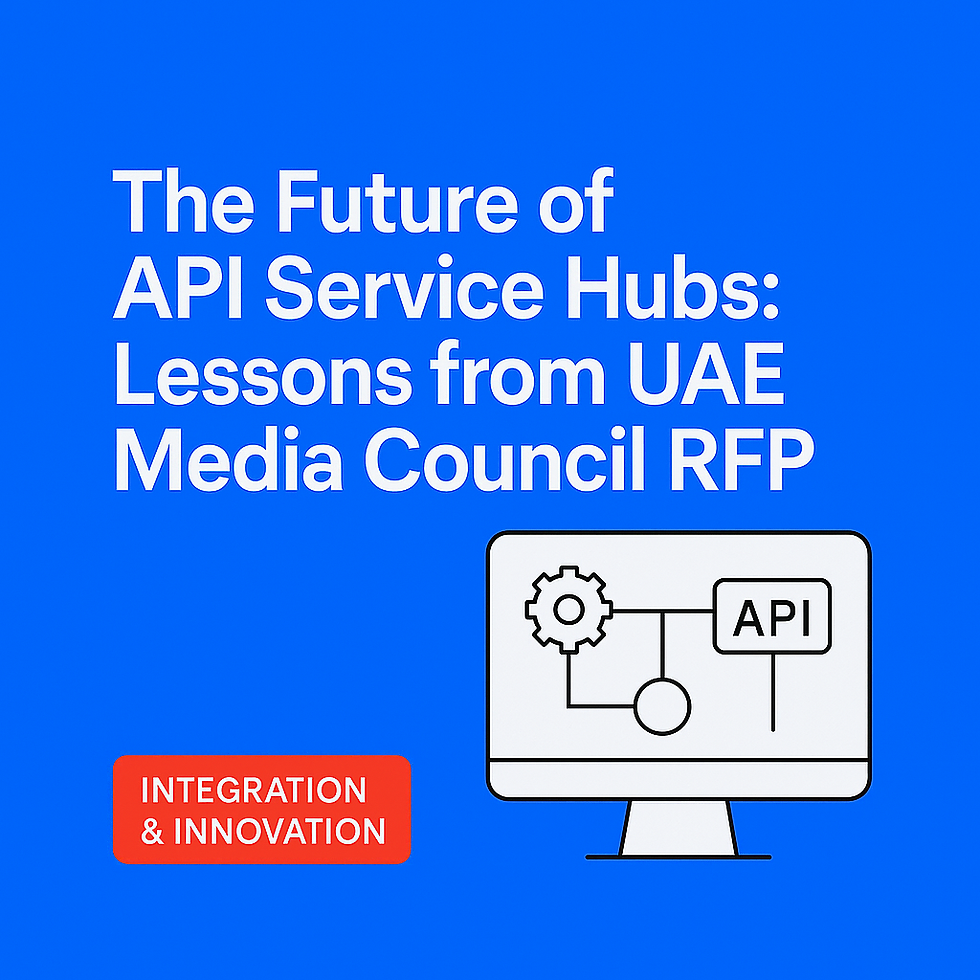- Cognigate Advisory Team

- Aug 28
- 3 min read

Introduction: Why API Hubs Are Now Mission-Critical
APIs (Application Programming Interfaces) are no longer just technical plumbing. They are the connective tissue of digital transformation. In fact, Gartner predicts that by 2025, over 80% of organizations will treat APIs as critical business assets, not just IT artifacts (Gartner).
McKinsey reinforces this shift:
“APIs can unlock data and business services, accelerate innovation, and create entirely new revenue streams.”
In the Middle East, where governments are rapidly modernizing public services, API hubs are emerging as national infrastructure. The UAE Media Council RFP is a prime example — highlighting how CIOs and transformation leaders must think about APIs not only as connectors, but as strategic enablers of HX (Human Experience).
Why Traditional Integration Is Not Enough
For decades, integration meant point-to-point connections or monolithic Enterprise Service Buses (ESBs). But that model breaks down when:
Citizens and employees demand real-time, mobile-first services.
Organizations juggle dozens of SaaS tools (CRM, ERP, ITSM, HRMS).
Governments mandate data sovereignty and compliance.
Accenture puts it clearly:
“Legacy integration is too slow, too brittle, and too costly for the pace of digital transformation.”
The Rise of API Service Hubs
An API hub (or API management platform) provides:
Discovery: A central catalog where APIs can be published and reused.
Security: Policies for authentication, throttling, monitoring.
Integration: Connecting old and new systems seamlessly.
Analytics: Visibility into API usage and performance.
Google Cloud notes:
“APIs are the products of the digital age — they need to be managed, secured, and designed for reuse.”
In the UAE Media Council case, the RFP made clear that APIs weren’t just technical requirements. They were the foundation for data transparency, media innovation, and citizen engagement.
Cognigate’s Lessons from the UAE Media Council RFP
1. Discover: Start with Outcomes, Not Endpoints
Instead of just listing “number of APIs to be exposed,” we worked with stakeholders to define outcomes:
Faster onboarding of media partners.
Seamless publishing of content across platforms.
Secure access for government and private collaborators.
“API strategies should be business-led, not IT-led.” — Cognigate
2. Design: Architect for Human Experience
APIs are invisible to end-users — but their effect is not. If APIs are slow, broken, or siloed, CX suffers immediately. Cognigate designs API hubs with HX metrics in mind:
Response times that match user expectations.
Consistent data across portals and apps.
Clear developer experience for adoption.
3. Deliver: Choose the Right Platform
In the RFP, Cognigate evaluated Boomi vs Peliqan:
Boomi: Enterprise-grade, proven for large-scale API management.
Peliqan: Modern, data-centric, designed for flexibility and automation.
Our recommendation: Peliqan for agility + Boomi as a long-term enterprise option. Both align with Cognigate’s philosophy: platforms must serve outcomes, not just features.
4. Drive: Govern and Evolve
APIs are living products. They require governance and evolution. Cognigate proposed:
API councils to decide which APIs are published or retired.
Analytics dashboards to track adoption.
Continuous compliance checks with UAE data laws.
Regional Context: Why This Matters for UAE and MENA
Government: UAE and KSA are mandating open data and APIs to empower ecosystems (media, education, healthcare).
Telecom: Operators use APIs to expose CPaaS, billing, and 5G capabilities.
Retail & F&B: APIs enable omni-channel — linking POS, e-commerce, loyalty, and supply chain.
Education: Universities use APIs to connect student information systems, portals, and mobile apps.
“The API economy in MENA is expected to grow at double digits annually, as governments and enterprises shift to open ecosystems.”
The Executive Playbook: How to Evaluate API Hub Strategies
Step 1 — Define Business Outcomes
What human or citizen experience are APIs enabling?
Which KPIs (adoption, satisfaction, revenue) should be tracked?
Step 2 — Balance Agility with Compliance
Cloud-native platforms (fast but need data checks).
On-prem/hybrid (secure but slower).
Hybrid often wins in UAE context.
Step 3 — Focus on Developer Experience
APIs are useless if developers don’t use them.
Invest in portals, documentation, and self-service.
Step 4 — Treat APIs as Products
Establish ownership.
Market APIs internally and externally.
Measure adoption like a customer product.
Step 5 — Build Governance Early
Define policies for access, throttling, and versioning.
Launch API councils for oversight.
Conclusion: APIs as the Nervous System of Transformation
APIs are not just technical assets — they are the nervous system of digital transformation. The UAE Media Council RFP proved that leaders now view APIs as strategic enablers of human experience, not IT checkboxes.
Gartner summarizes it well:
“APIs are the building blocks of digital business. Without them, organizations cannot scale or innovate.”
At Cognigate, our lesson is clear: APIs must serve people first. The future of API hubs lies in combining agility, governance, and HX to deliver sustainable transformation.


